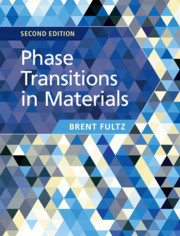Book contents
- Frontmatter
- Contents
- Preface
- Notation
- Part I Basic Thermodynamics and Kinetics of Phase Transformations
- Part II The Atomic Origins of Thermodynamics and Kinetics
- Part III Types of Phase Transformations
- 11 Thermodynamics and Phase Transitions at Surfaces
- 12 Melting
- 13 Solidification
- 14 Phase Transformations with Interfaces: 1. Microstructure
- 15 Phase Transformations with Interfaces: 2. Energetics and Kinetics
- 16 Spinodal Decomposition
- 17 Phase Field Theory
- 18 Method of Concentration Waves and Chemical Ordering
- 19 Diffusionless Transformations
- 20 Thermodynamics of Nanomaterials
- 21 Magnetic and Electronic Phase Transitions
- Further Reading
- References
- Index
13 - Solidification
from Part III - Types of Phase Transformations
Published online by Cambridge University Press: 24 April 2020
- Frontmatter
- Contents
- Preface
- Notation
- Part I Basic Thermodynamics and Kinetics of Phase Transformations
- Part II The Atomic Origins of Thermodynamics and Kinetics
- Part III Types of Phase Transformations
- 11 Thermodynamics and Phase Transitions at Surfaces
- 12 Melting
- 13 Solidification
- 14 Phase Transformations with Interfaces: 1. Microstructure
- 15 Phase Transformations with Interfaces: 2. Energetics and Kinetics
- 16 Spinodal Decomposition
- 17 Phase Field Theory
- 18 Method of Concentration Waves and Chemical Ordering
- 19 Diffusionless Transformations
- 20 Thermodynamics of Nanomaterials
- 21 Magnetic and Electronic Phase Transitions
- Further Reading
- References
- Index
Summary
There is a marked kinetic asymmetry between melting and solidification -- the two are quite different as phase transformations. Solidification can occur by different mechanisms that create very different solid microstructures. This chapter emphasizes processes at the solid-liquid interface during solidification, and the microstructure and solute distributions in the newly formed solid. During solidification, a solid-liquid interface moves forward as the liquid is consumed, and the velocity of the interface increases with the rate of heat extraction. Instabilities set in even at relatively small velocity, however, and a flat interface evolves into finger-like columns or tree-like dendrites of growing solid. This instability is driven by the release of latent heat and the partitioning of solute atoms at the solid-liquid interface. Finger-like solids have more surface area, so countering the instability is surface energy. Solidification involves the evolution of several coupled fields. Crystallographic orientation of the growing solid phase is also important for the growth rate and surface energy.
Keywords
Information
- Type
- Chapter
- Information
- Phase Transitions in Materials , pp. 342 - 372Publisher: Cambridge University PressPrint publication year: 2020
